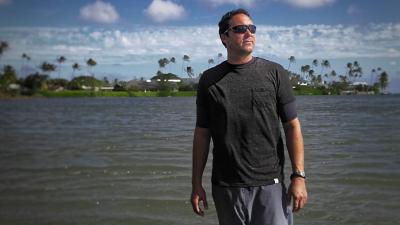
Credit: University of Hawai’i
Twice as much freshwater is stored offshore of Hawai’i Island than was previously thought, according to a University of Hawai’i study with important implications for volcanic islands around the world. An extensive reservoir of freshwater within the submarine southern flank of the Hualālai aquifer has been mapped by UH researchers with the Hawai’i EPSCoR ‘Ike Wai project. The groundbreaking findings, published in Science Advances, reveal a novel way in which substantial volumes of freshwater are transported from onshore to offshore submarine aquifers along the coast of Hawai’i Island.
This mechanism may provide alternative renewable resources of freshwater to volcanic islands worldwide. “Their evidence for separate freshwater lenses, stacked one above the other, near the Kona coast of Hawai’i, profoundly improves the prospects for sustainable development on volcanic islands,” said UH Mānoa School of Ocean and Earth Science and Technology (SOEST) Dean Brian Taylor.
Paradigm shift
Through the use of marine controlled-source electromagnetic imaging, the study revealed the onshore-to-offshore movement of freshwater through a multilayer formation of basalts embedded between layers of ash and soil, diverging from previous groundwater models of this area. Conducted as a part of the National Science Foundation-supported ‘Ike Wai project, research affiliate faculty Eric Attias led the marine geophysics campaign.
“Our findings provide a paradigm shift from the conventional hydrologic conceptual models that have been vastly used by multiple studies and water organizations in Hawai’i and other volcanic islands to calculate sustainable yields and aquifer storage for the past 30 years,” said Attias. “We hope that our discovery will enhance future hydrologic models, and consequently, the availability of clean freshwater in volcanic islands.”
Co-author Steven Constable, a professor of geophysics at the Scripps Institution of Oceanography, who developed the controlled source electromagnetic system used in the project, said, “I have spent my entire career developing marine electromagnetic methods such as the one used here. It is really gratifying to see the equipment being used for such an impactful and important application. Electrical methods have long been used to study groundwater on land, and so it makes sense to extend the application offshore.”
Kerry Key, an associate professor at Columbia University who employs electromagnetic methods to image various oceanic Earth structures, who not involved in this study, said, “This new electromagnetic technique is a game changing tool for cost-effective reconnaissance surveys to identify regions containing freshwater aquifers, prior to more expensive drilling efforts to directly sample the pore waters. It can also be used to map the lateral extent of any aquifers already identified in isolated boreholes.”
Two-times more water
Donald Thomas, a geochemist with the Hawai’i Institute of Geophysics and Planetology in SOEST who also worked on the study, said the findings confirm two-times the presence of much larger quantities of stored groundwater than previously thought.
“Understanding this new mechanism for groundwater…is important to better manage groundwater resources in Hawai’i,” said Thomas, who leads the Humu?ula Groundwater Research project, which found another large freshwater supply on Hawai’i Island several years ago.
Offshore freshwater systems similar to those flanking the Hualālai aquifer are suggested to be present for the island of O’ahu, where the electromagnetic imaging technique has not yet been applied, but, if demonstrated, could provide an overall new concept to manage freshwater resources.
The study proposes that this newly discovered transport mechanism may be the governing mechanism in other volcanic islands. With offshore reservoirs considered more resilient to climate change-driven droughts, volcanic islands worldwide can potentially consider these resources in their water management strategies.
###
This project is supported by the National Science Foundation EPSCoR Program Award OIA #1557349.
LINK TO VIDEO AND SOUND (TRT 3:29): https:/
BROLL (2:30) (credit: University of Hawai’i):
10 Video clips of the deployment of the CSEM system off of Hawai’i Island.
Close-up pan of the surface-towed marine controlled-source electromagnetic (CSEM) system called Porpoise.
Image of resistivity models
Image of new conceptual model, showing layers of freshwater between layers of basalt
5 Video clips of Eric Attias, University of Hawai’i research affiliate faculty, at Wailupe Beach Park on O’ahu and freshwater bubbling up at the shoreline
SOUND:
Eric Attias, University of Hawai’i research affiliate faculty (:13)
“The main result of that discovery is that we found deep submarine reservoirs of fresh water. They are embedded in layers beneath the surface of the sea floor.”
Attias (:22)
“So, with this discovery, that means that these islands can do the same what we implemented here in the Big Island and can discover the abundance of freshwater within very close proximity to their islands which really will improve their water budget.”
Attias (:24)
“We used electromagnetic imaging, which is similar to an MRI of the brain. We basically project an electromagnetic wave that goes through the subsurface and then records the returning signal in terms of amplitude and phase and then we see how the field is changing.”
Link to still photos/images and captions (credit: University of Hawai’i): https:/
1. Eric Attias environmental portrait.jpg
Caption: University of Hawai’i Research Affiliate Faculty Eric Attias at Wailupe Beach Park on O’ahu.
2. Eric Attias deploying CSEM System.jpg
Caption: Eric Attias (middle) deploying the surface-towed marine controlled-source electromagnetic (CSEM) system off of Hawai’i Island.
3. Surface -towed CSEM off Hawai’i Island.jpeg
Caption: The surface-towed marine controlled-source electromagnetic (CSEM) system in the ocean off of Hawai’i Island.
4. Porpoise system graphic.jpg
Caption: illustration of the surface-towed marine controlled-source electromagnetic (CSEM) system called Porpoise.
5. New Conceptual Model graphic.jpg
Caption: Illustration showing a multilayer conceptual model of the transport mechanism of fresh groundwater from onshore to offshore in Hawai’i.
Link to video and sound (details below): https:/
Media Contact
Kelli Abe Trifonovitch
[email protected]




